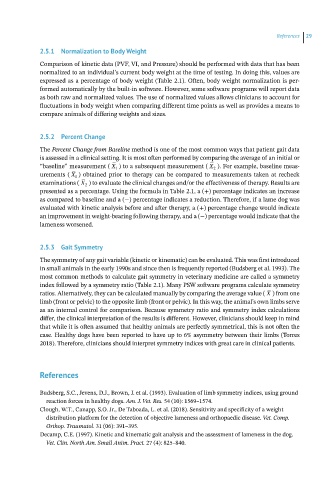Page 57 - Canine Lameness
P. 57
eferences 29
2.5.1 Normalization to Body Weight
Comparison of kinetic data (PVF, VI, and Pressure) should be performed with data that has been
normalized to an individual’s current body weight at the time of testing. In doing this, values are
expressed as a percentage of body weight (Table 2.1). Often, body weight normalization is per-
formed automatically by the built‐in software. However, some software programs will report data
as both raw and normalized values. The use of normalized values allows clinicians to account for
fluctuations in body weight when comparing different time points as well as provides a means to
compare animals of differing weights and sizes.
2.5.2 Percent Change
The Percent Change from Baseline method is one of the most common ways that patient gait data
is assessed in a clinical setting. It is most often performed by comparing the average of an initial or
“baseline” measurement ( X ) to a subsequent measurement ( X ). For example, baseline meas-
2
1
urements ( X ) obtained prior to therapy can be compared to measurements taken at recheck
1
examinations ( X ) to evaluate the clinical changes and/or the effectiveness of therapy. Results are
2
presented as a percentage. Using the formula in Table 2.1, a (+) percentage indicates an increase
as compared to baseline and a (−) percentage indicates a reduction. Therefore, if a lame dog was
evaluated with kinetic analysis before and after therapy, a (+) percentage change would indicate
an improvement in weight‐bearing following therapy, and a (−) percentage would indicate that the
lameness worsened.
2.5.3 Gait Symmetry
The symmetry of any gait variable (kinetic or kinematic) can be evaluated. This was first introduced
in small animals in the early 1990s and since then is frequently reported (Budsberg et al. 1993). The
most common methods to calculate gait symmetry in veterinary medicine are called a symmetry
index followed by a symmetry ratio (Table 2.1). Many PSW software programs calculate symmetry
ratios. Alternatively, they can be calculated manually by comparing the average value ( X ) from one
limb (front or pelvic) to the opposite limb (front or pelvic). In this way, the animal’s own limbs serve
as an internal control for comparison. Because symmetry ratio and symmetry index calculations
differ, the clinical interpretation of the results is different. However, clinicians should keep in mind
that while it is often assumed that healthy animals are perfectly symmetrical, this is not often the
case. Healthy dogs have been reported to have up to 6% asymmetry between their limbs (Torres
2018). Therefore, clinicians should interpret symmetry indices with great care in clinical patients.
References
Budsberg, S.C., Jevens, D.J., Brown, J. et al. (1993). Evaluation of limb symmetry indices, using ground
reaction forces in healthy dogs. Am. J. Vet. Res. 54 (10): 1569–1574.
Clough, W.T., Canapp, S.O. Jr., De Taboada, L. et al. (2018). Sensitivity and specificity of a weight
distribution platform for the detection of objective lameness and orthopaedic disease. Vet. Comp.
Orthop. Traumatol. 31 (06): 391–395.
Decamp, C.E. (1997). Kinetic and kinematic gait analysis and the assessment of lameness in the dog.
Vet. Clin. North Am. Small Anim. Pract. 27 (4): 825–840.

